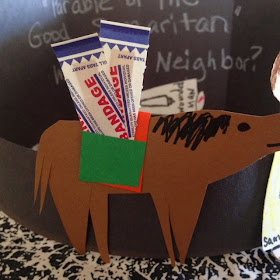VERSES: Luke 14:12-24
MEMORY VERSE: Luke 14:23 "...Go out into the highways and hedges, and compel them to come in, that my house may be filled."
BOOK TO REMEMBER: 1 Samuel. Write "1 Samuel" on small slips of paper and hand out at the end of class, so the students may memorize the ninth book of the Old Testament.
PRAYER: Thank God for all that He gives us.and may we appreciate all of God's gifts, being thankful always.
SPECIAL SONG: Jesus Taught By Parables And Miracle (see March 2014 - Songs We Sing In Bible Class #4 on this blog. Click on orange circle to hear tune.)
VISUAL AID: Large Activity (see below)
LESSON POINTS:
- Jesus told another parable to those who were listening to Him. He said that there was a man who prepared a great supper or dinner and invited many to come and eat with him. He sent his servants to go and tell the invited guests to come to his house because everything was ready for them
- His friends who he had invited all began to make excuses why they could not come. One man said that he had bought a piece of land and had to go and see it. He asked to be excused. A second man who had been invited to the supper said that he had bought five yoke of oxen and he need to go and test them. He asked to be excused. A third man who also had been invited to the supper gave a simple excuse. He said that he had married a wife and could not come. He did not even ask to be excused!
- When the servants returned without any of the master's friends coming to enjoy their master's supper and brought him their excuses instead, the man who had prepared the supper became very angry and said to his servant, "Quickly go out into the streets and lanes of the city and bring in the poor, the wounded, the crippled, and the blind people" The servant did as he was told and he reported back to his master that there was still room for more people. The master told his servant to again go out to the highway or the main road and the hedges (which were walls made out of loose stones) and urge people to come in that the master's house would be filled.
- What this parable meant: Jesus told the people who were listening to Him that God had made a great invitation to His people, the Jews, to come into God's kingdom. When the Jews would refuse His invitation, then God would invite any and all into His kingdom.
- To refuse such a grand invitation to a banquet of a rich man was a great insult in Bible times. It is no wonder the master was angry in this parable. God, too, must be insulted to have people today refuse His grand invitation to enter His kingdom, the church.
ACTIVITY: The Parable of the Great Supper
Materials needed: 9" x 12" white paper, crayons.
- Hand out white paper.
- Fold 3" down on the top edge of the paper.
- Fold the paper then in thirds (see picture below).
- Fold the bottom edge of the paper up 2".
- Trace the inside lines and the top and bottom lines (see picture).
- Write "Come! All Things Are Ready!" and "Parable of the Great Feast - Luke 14:15-24 in the long top box.
- Write "Excuse #1", "Excuse #2", and "Excuse #3" in the three smaller boxes in the middle of the paper.
- At the bottom of the Excuse #1 box, write "Bought land. Must see it."
- At the bottom of Excuse #2 box, write "Bought oxen. Must test them."
- At the bottom of Excuse #3 box, write "Married a wife."
- In the long box on the bottom, write "Quickly! Bring in the poor, wounded, crippled, lame." in red. Write "There is more room." in blue. Write "Go to the highways and hedges. Urge them to come, so my house will be filled." in red. (If the students' handwriting is too large for this box, simply turn the paper over and write on the back of the paper.)
- Draw an appropriate picture in each of the three "excuses" boxes.





























